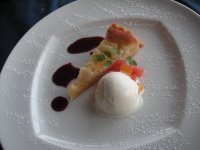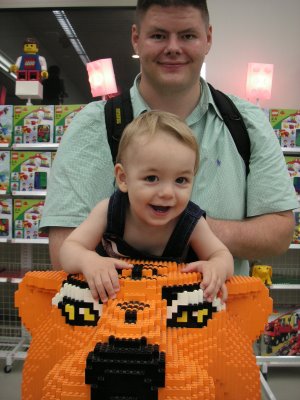A four week summer vaccation may be unreasonably short when coming from the good ol’ US of A where a three month holliday is the norm for public schools, but as the humidity level rises and it becomes unbearably hot here in Japan, those four weeks are awfuly nice. This year we’ve made the most of it.

Iizuna Kogen
飯綱高原
Along with our friend Keiko and her lovely daughters and mother, we made for the mountains. Nestled in the Japanese Alps, there are many nearby little get-aways here in Nagano. We have not yet made it to all of these little retreat towns, but we finally made it to Iizuna Kogen. Here we toured a museum dedicated to apples, the region’s specialty, before heading to St. Corsaire.

St. Corsaire
サンクゼール
 St. Corsaire is a winery, specialty jams & jellies shop, resturaunt, and chapel that cater to Japanese cravings for things European. The food and the view was spectacular, the atmosphere mesmorizing, and the experience unforgettable. After lunch Keiko’s daughters and Ammon enjoyed running on the grass near the vinyards, a treasured treat, especially when considering that it was Ammon’s first time on grass and the girls never see any in the big city they live in.
St. Corsaire is a winery, specialty jams & jellies shop, resturaunt, and chapel that cater to Japanese cravings for things European. The food and the view was spectacular, the atmosphere mesmorizing, and the experience unforgettable. After lunch Keiko’s daughters and Ammon enjoyed running on the grass near the vinyards, a treasured treat, especially when considering that it was Ammon’s first time on grass and the girls never see any in the big city they live in.
 Nagasaki 長崎
Nagasaki 長崎
Nagasaki is a beautiful port city. Most of the city is nestled on the hills that overlook the harbor. It is the best place to see how Japan has mingled with the rest of the world through its rough history, as it was the only port to the outside world for nearly 200 years, the site of the Martyrdom of the 26 Saints of Japan's first Christians, and was completely destroyed by an atomic bomb. Monica and I started off in Dejima (the historicaly dutch quarter) then went through Shinchi Chinatown, and hiked up to the place we would spend the night in the hills. The hike was amazing, we walked past the prefectural museums and parks and past a few famous shrines.  The hills had giant “holy” trees called Go-Shimboku ご神木 hanging over the walkways, some growing right in the middle of the street. As we made our way up the hillside we took a photo of the moonlit sky. We may have escaped our comparably cool lofty abode in the Japanese Alps to find the truly miserable heat of the southern island, but the experience made it well worth the discomfort.
The hills had giant “holy” trees called Go-Shimboku ご神木 hanging over the walkways, some growing right in the middle of the street. As we made our way up the hillside we took a photo of the moonlit sky. We may have escaped our comparably cool lofty abode in the Japanese Alps to find the truly miserable heat of the southern island, but the experience made it well worth the discomfort.

Sasebo
佐世保
Monica and I, relying on the generosity of our guests Kirsten & Jessica to baby sit Ammon for a couple days, took off for Sasebo. Sasebo is my grandmother’s home town, originally a fishing villiage, it became a naval port and has seen the changes and challenges that have made Japan what it is today. While there we passed through
Huis Ten Bosch, a recreation of a Dutch port town, visited the Sasebo Zoological and Botanical Gardens, and went on a Sunset Cruise through Sasebo’s 99 Islands.

99 Islands
九十九島
We borded the large yacht at 6:15 when the sun still shown brightly, but had already moved far to the western corner of the sky. The lower decks were airconditioned, but we prefered the better view with nothing but sky above us – the gentle breeze cooling us as the boat manouvered the islands. Both Monica and I could not help but remember our honeymoon in the Bahamas.

The islands were prestine. Very few of them ever saw the foot of a man though a few fishing poles were seen poking out on the quite side of some of the islands. As the sun gradually descended further and further into the western horrizon, the colors of the sky and water changed hues and intensified. As it sank I snapped as many shots as I could as the boat’s view of the orange water and pink sky opened up between islands. It took hours after returning to port before our breaths returned, having been taken by the beauty of the 99 Islands of my grandmother’s home.

Karuizawa
軽井沢
Karuizawa is another mountain resort town hidden in Nagano's Japanese Alps. This town is famed much like Aspen, CO or Park City, UT with frequent visits by Japan's celebrities. The shopping was outrageously expensive, but there ware some specialty stores that made our day such as the one where I bought a six-pack of rootbeer! Oh how I miss rootbeer! There was also a Lego™ outlet. While walking through the store Ammon surprized me when I heard him saying "Grrrrr" to a 4ft tiger made out of Legos. I lifted him out of the stroller and he was quite thrilled to have his picture taken with his new orange & black-striped friend.

Tokyo DisneySea
Built adjacent to Tokyo Disneyland is
Tokyo DisneySea. We spent most of our time at Tritan's Kingdom (think
Little Mermaid) and the Arabian Coast (think
Aladin and
Sinbad). Ammon was scared to death of Mickey and the other characters, I tried to capture the terror in the pictures I snapped.

It was so muggy we struggled to breathe in the heat, but we had fun like we were all six years old again. We are totally going to Tokyo Disneyland next year!

Daiō Wasabi Farm
大王わさび農場

What do you know of wasabi (Japanese horseradish)? Haven't you always wanted to know more? It is a mountain river plant that is grown in shaded fields of frigid cold runing mountain water. The largest wasabi farm in Japan is in Hotaka only an hour south of our apartment. We toured the fields, and sampled some wasabi flavored foods including icecream and chocolate! yumm!
 However, he is our little baby boy and as parents it is our duty to turn him from tarzaan-ape-boy to an upright-walking young gentleman. To do this we discourage him from swinging from our table cloth and pulling mommy's lunch onto his head, and encourage him to swing on normal swings. After beating his chest, hooting, and eating another bananna, he agreed to pose with his mommy for a few pics.
However, he is our little baby boy and as parents it is our duty to turn him from tarzaan-ape-boy to an upright-walking young gentleman. To do this we discourage him from swinging from our table cloth and pulling mommy's lunch onto his head, and encourage him to swing on normal swings. After beating his chest, hooting, and eating another bananna, he agreed to pose with his mommy for a few pics. 


 The hills had giant “holy” trees called
The hills had giant “holy” trees called 








